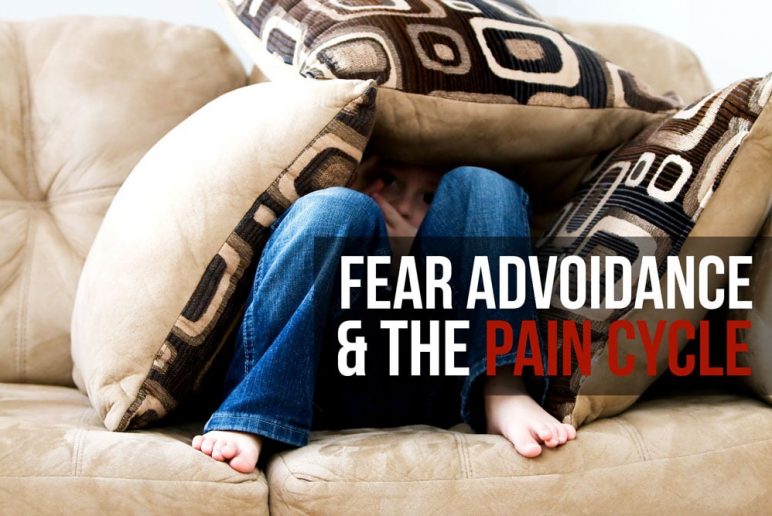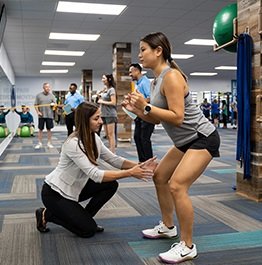
Fear Avoidance and the Pain Cycle
July 26, 2018Have you ever been in pain and were fearful to move because the pain would worsen? Or that you would cause more damage? Did you ever think that not moving could be bad? This fear avoidance behavior can actually cause more pain. In fact, avoidance of movement can also increase one’s stress and alter one’s central nervous system leading to decreased healing.
Fear Avoidance Behavior
For anyone with a painful experience it is important that something must be done. The experience is worth paying attention to and focusing on. The experience teaches us how to prevent the experience in the future. This is a natural occurrence due to our natural instinct for survival, however until it becomes fear avoidance behavior and one begins to imprint this behavior into their brain and daily life. This behavior can then cause more harm than good.
For Example:
Someone with a sprained ankle will limp to reduce pain because it is natural for us to do so to not further injure the ankle. However, if one continues to limp due to fear of spraining the ankle again this can lead to knee, hip, and low back pain leading to a vicious cycle of never ending pain. This can affect one’s social life, independence, and overall quality of life.
Pain Alters Central Nervous System & Brain Output
When the body senses pain, our “fight or flight” (sympathetic) nervous system kicks in.
- The increased activation of the sympathetic system leads to decreased immune response and increased emotional state and stress.
- There is an increase of stress hormone levels leading to increased inflammation, decreased tissue recovery, and increased pain sensitivity.
The Pain Cycle
Pain leads to fear avoidance behavior. Fear avoidance behavior leads to decreased quality of life. Decreased quality of life leads to stress. Stress leads to more pain. More pain leads to increased pain sensitivity via sympathetic nervous system…and the cycle continues.

How Can a Physical Therapist Help?
- A physical therapist can educate patients about their pain. Allowing them to grab hold and understand their pain rather than having their pain grabbing ahold of them first.
- A physical therapist will help patients focus on meaningful and purposeful movement. They can help give patients control and empower them to alter CNS/brain processing systems that are detrimental to their healing.
- American Physical Therapy Association’s vision statement for the physical therapy profession: "Transforming society by optimizing movement to improve the human experience"
Sign up below for an appointment with one of our physical therapists to get started with hands-on treatment and a personalized exercise plan for your back or shoulder pain!
A representative will be in touch shortly.WANT MORE FREE PAIN-RELIEF & HEALTH TIPS?
Sign up for LIFE+ TODAY to have these practical tips sent straight to your inbox!References: Gifford, L (1998). Pain, the Tissues and the Nervous System: A conceptual model, Physiotherapy, 84, 27-36.
Christy enjoys spending time with family and friends and being physically active playing a variety of sports. She is frequently outside hiking, fishing, and camping – enjoying nature’s beauty and the fresh open air.
Latest posts by Christy Nguyen, PT, DPT (see all)
- Self Soft Tissue Mobilization of the Hamstrings - June 10, 2021
- Common Household Items for Stretching & Pain Relief - May 18, 2019
- Get Wise & Deskercise: How to Exercise at Your Desk - March 08, 2019
- Fear Avoidance and the Pain Cycle - July 26, 2018
- A Hike to Remember: Little Lakes Valley - December 12, 2017
- Brussels Sprouts: Fear No More! - December 05, 2017
- Improving Desk Ergonomics - November 16, 2017
- Get Up and Get Moving: Reduce Your Sedentary Footprint! - November 06, 2017
- Wear Your Hair Down Before it Wears You Out! - October 18, 2017
Reader Interactions
Leave a comment Cancel reply
You must be logged in to post a comment.
SIGN UP FOR
LIFE+ is a FREE membership
that offers:
• Informative Newsletters
• Health & Wellness Tips
• Videos from Our Experts
• Special offers
…and much more!
SEARCH

GET MORE TIPS! PAIN 101 TUTORIALS
EXPLORELATEST TWEETS
ARCHIVES
- February 2025
- August 2024
- February 2024
- November 2023
- September 2023
- July 2023
- June 2023
- January 2023
- November 2022
- October 2022
- September 2022
- August 2022
- July 2022
- June 2022
- May 2022
- April 2022
- March 2022
- December 2021
- November 2021
- October 2021
- September 2021
- August 2021
- July 2021
- June 2021
- April 2021
- March 2021
- February 2021
- January 2021
- December 2020
- November 2020
- October 2020
- September 2020
- August 2020
- April 2020
- March 2020
- February 2020
- January 2020
- December 2019
- November 2019
- October 2019
- September 2019
- August 2019
- July 2019
- June 2019
- May 2019
- April 2019
- March 2019
- February 2019
- January 2019
- November 2018
- September 2018
- August 2018
- July 2018
- June 2018
- May 2018
- April 2018
- March 2018
- February 2018
- January 2018
- December 2017
- November 2017
- October 2017
- September 2017
- August 2017
- July 2017
- June 2017
- May 2017
- April 2017
- March 2017
- February 2017
- January 2017
- December 2016
- November 2016
- October 2016
- September 2016
- August 2016
- July 2016
- June 2016
- May 2016
- April 2016
- March 2016
- February 2016
- January 2016
- December 2015
- November 2015
- October 2015
- September 2015
- August 2015
- July 2015
- June 2015
- May 2015
- April 2015
- March 2015
- February 2015
- January 2015
- December 2014
- November 2014
- October 2014
- September 2014

